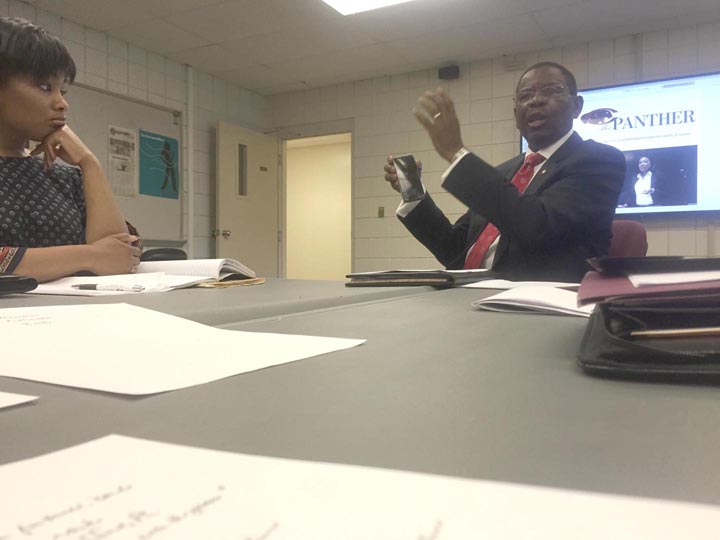Claflin president shares vision, says Jonas T. Kennedy Center expansion to be reality
By: John Mack
May 11, 2016

As the 2015-16 academic year came to a close, Claflin President Dr. Henry N. Tisdale said the university is implementing changes to enhance the quality of campus life.
During a news conference with The Panther, Claflin’s student newspaper, Tisdale outlined plans and reinforced his commitment to the university as a leading institution of higher learning. And the president of 22 years said he hopes to be at Claflin for up to five more years.
“My passion is excellence and leadership development and confidence … I want to bring excellence,” Tisdale said. From the time of his arrival in 1994, Tisdale said he has aimed to position Claflin as a leading institution, strengthen the faculty and provide top academic programs.
Over the summer, work toward the expansion of the Jonas T. Kennedy Center will continue, Tisdale said. Construction on the $8 million project is to begin in early 2017.
The expansion will create a Health and Wellness Center, which will include an indoor track, classrooms, office spaces, labs, group fitness areas, a fitness center, locker rooms, a demonstration kitchen and an auxiliary gym where students can have the freedom of a free and unoccupied space.
The JTK additions will not include an aquatic center.
“For years we had the aquatic center as part of the plan,” Tisdale said. “$8 million is not going to get us a pool. [It’s] not important enough to take the cost."
The renovations come with the primary focus placed on the health and welfare of the student body, Tisdale said. “In keeping with Claflin University’s overall vision, we want the Health and Wellness Center to be recognized as a premier comprehensive and cohesive health and wellness center which provides athletic facilities, educational space, relevant technology, incorporates sustainable design principles, and enhances and enriches the lives of our students and our community.”
Along with the gym, plans have also been made to replace primary waterlines that feed the campus.
The low water pressure in dorms has been a concern to students and the problem can be remedied by installing new pipes, Tisdale said. The work is to begin this summer and be completed within four to six months.
When students return in the fall, they will also experience a number of other facilities enhancements to include upgrades in James S. Thomas Science Center, computer lab retrofit in Laymen Hall, new bookstore makeover and transformation of the current mailroom to a Mail, Copy/Print, Pack/Ship service center.
Tisdale said tuition at Claflin for the new year will increase by 3 percent -- about $448 a year.
For students living on campus, the cost per year (which includes tuition, room and board) will be about $25,000. For Kleist Hall, the new price is $25,944 and $27,222 for students staying in the SRC Halls. Off-campus students will pay $15,000-16,000 a year.
“It does become necessary to have some modest increases,” Tisdale said. Factors include increased costs, faculty salaries, improving student life and upgrading facilities.
Faculty is a priority, Tisdale said. "We will never be any better than our faculty."
Even with the increase, Claflin tuition is 30 percent lower than the average private liberal arts institution and only three private institutions in South Carolina have lower overall costs, Tisdale said.
While tuition is rising, the cost of summer school classes has been reduced and assistance for students will be made available, Tisdale said.
Also, the university will be offering online courses at a reduced price this year. Previously, the cost per credit hour was $620. It will now be $475, giving more students the opportunity to gain college credits.
Attracting students is a focus of the university. Strategies to do so include collaborating with two-year institutions such as Orangeburg-Calhoun Technical College to bring those students onto the Claflin campus, growing online products and a changing the university’s website to be more attractive to students.
A full change in the website will come in October or November, Tisdale said.
New programs will be added to the curriculum, Tisdale said. These include a new bachelor’s degree nursing program (RN to BSN) and an applied computing minor.
A minor can “make you more competitive in terms of employment,” Tisdale said.
From 900 students when he came two decades ago, Claflin enrollment will grow to about 2,000 students in the coming year, Tisdale said. That is an increase of 2.5 percent from fall 2015 to fall 2016.
Growth in enrollment does not mean continuing to expand the traditional student population, he said. Claflin will cut off recruitment for the coming year earlier than normal except for graduate, professional and continuing studies and online students.
There is not much room for growth in the traditional student population of those living on campus for regular fall and spring terms, Tisdale said.
Claflin could ultimately reach a student population of 2,500, but real growth will come among non-traditional students. Undergraduate enrollment likely will top out at 1,700-1,800 with about 1,200 living on campus.
For fall 2016, enrollment will be 1,600 traditional undergraduates with 1,200 living on campus.
Tisdale addressed a question about his plans for retirement by stating, "I plan on being at Claflin for a few more years” – with the approval of the board of trustees.
He said he will not be at the university forever, but there are more things to accomplish before leaving. Most notably, he wants to see a new five-year plan through to fruition.
The long-range plan is to be voted on by Claflin trustees this summer.